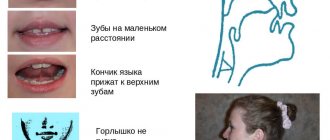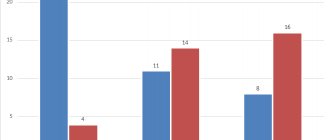Diagnosis and correction of dyslexia in primary schoolchildren. methodological development (1st grade)
MUNICIPAL EDUCATIONAL INSTITUTION
GYMNASIUM No. 44
MUNICIPAL FORMATION Luberetskiy MUNICIPAL DISTRICT OF MOSCOW REGION
MO "Basis"
Report on the topic:
Completed:
primary school teacher
Afanasyeva N.S.
Lyubertsy, 2021
For the first time, A. Kussmaul pointed out reading and writing disorders as an independent pathology of speech activity in 1877. Then many works appeared in which descriptions of children with various reading and writing disorders were given.
Over time, various forms of dyslexia and dysgraphia began to be identified, and classifications of reading and writing disorders appeared.
In modern literature, the following terms are used to denote reading disorders: “Alexia” - to denote a complete lack of reading and “dyslexia” - this is a partial specific violation of the reading process, caused by the immaturity (impairment) of higher mental functions and manifested in repeated errors of a persistent nature.
The prevalence of reading disorders among children is quite high. About 5-8 percent of schoolchildren suffer from dyslexia. There is a genetic predisposition to the presence of this disorder. Reading disabilities often become apparent by 2nd grade. Sometimes dyslexia is compensated over time, but in some cases it remains at an older age.
Etiology.
The question of the etiology (i.e., the causes) of dyslexia is still controversial.
Dyslexia may be based on various etiological factors:
* biological reasons. Underdevelopment or damage to the brain during different periods of child development (prenatal, natal, postnatal), pregnancy pathologies, fetal trauma, asphyxia, meningoencephalitis, severe somatic diseases and infections that deplete the child’s nervous system. As a result, parts of the brain that provide psychological functions involved in the process of writing and reading suffer.
* socio-psychological reasons. Such reasons include insufficient speech contacts, pedagogical neglect, etc.
Classification.
Over the years of studying this problem, different authors have identified types of dyslexia and classifications. It is based on various criteria: manifestations, degree of severity of reading disorders (R. Becker), disturbances in the activity of analyzers involved in the act of reading (O. A. Tokareva), violation of certain mental functions (M. E. Khvattsev, R. E. Levin and others), accounting for the operations of the reading process (R. I. Lalaeva).
The following forms of dyslexia are distinguished:
Phonemic dyslexia is dyslexia associated with underdevelopment of the functions of the phonemic system and sound-letter analysis.
Semantic dyslexia (Greek semantikos - semantic) is dyslexia, manifested in impaired understanding of words, sentences, texts read with technically correct reading.
Agrammatic dyslexia is dyslexia caused by underdevelopment of the grammatical structure of speech, morphological and syntactic generalizations.
Mnestic dyslexia (Greek mnesis - semantic) is dyslexia, manifested in difficulties in mastering all letters, in their undifferentiated substitutions.
Optical dyslexia (Greek optikos - related to vision) is dyslexia, manifested in difficulties in learning and in mixing graphically similar letters, as well as in their mutual substitutions. With organic brain damage, mirror reading can be observed. Literal optical dyslexia is also distinguished, in which there are impairments in isolated letter recognition and discrimination, and verbal optical dyslexia, which manifests itself in impairments in word reading.
Tactile dyslexia (lat. tactilis - tactile) is dyslexia, which is observed in blind children and manifests itself in difficulties in differentiating tactilely perceived letters of the Braille alphabet.
Principles.
In the process of speech therapy work to correct reading disorders, the following principles are the most significant.
The principle of systematicity is based on the idea of speech as a complex functional system, the structural components of which are in close interaction. In this regard, the study of speech, the process of its development and correction of disorders involves influencing all components, all aspects of the speech functional system.
Speech disorders in many cases are included in the syndrome of nervous and neuropsychiatric diseases (for example, dysarthria, alalia, stuttering, etc.). Elimination of speech disorders in these cases should be comprehensive, medical, psychological and pedagogical in nature. Thus, when studying and eliminating speech disorders, the principle of complexity is important.
In the process of studying speech disorders and their correction, it is important to take into account the general and specific patterns of development of abnormal children. The principle of development involves identifying, in the process of speech therapy examination and work, those tasks, difficulties, and stages that are in the zone of proximal development of the child.
The development of methods of correctional and speech therapy is carried out taking into account the appearance of the forms and functions of speech, as well as the types of activities of the child in ontogenesis (ontogenetic principle).
Pathogenetic principle (i.e. the principle of taking into account the mechanism of the disorder). In many cases, reading disorders with identical symptoms are based on different mechanisms.
Symptoms.
Reading errors in dyslexia are specific. The following specific reading errors are observed:
Replacement and mixing of sounds when reading: replacement and mixing of phonetically similar sounds (voiced and voiceless, affricates and sounds included in their composition, etc.), as well as replacement of graphically similar letters (x-zh, p-n, z-v and etc.).
Letter-by-letter reading is a violation of the merging of sounds into syllables and words. When reading letter by letter, the letters are named one by one, “stacked”, strung one on top of the other. For example, FRAME - P, A, M, A.
Distortions of the sound-syllable structure of a word, which manifest themselves in a variety of errors: a) omission of consonants during a confluence, b) omission of consonants and vowels in the absence of a confluence, c) adding sounds, d) rearrangements of sounds, e) omissions, rearrangements of syllables, etc.
Reading comprehension deficits occur at the single-word, sentence, and text levels. This group of reading disorders is identified in cases where there are no disorders of the technical side of the reading process.
Agrammatisms when reading. This group of errors manifests itself at the analytical-synthetic and synthetic stages of mastering reading skills. There are violations in case endings, in agreement between noun and adjective, changes in verb endings, etc.
It is important to note here that the existence of reading errors in children does not prove the presence of dyslexia. Similar errors can occur in a child who does not suffer from dyslexia. In this case, the errors will be random in nature and the cause will be inattention, insufficient control processes when reading due to the child’s fatigue.
To correctly diagnose the pathology, it is necessary to know the developmental norm. Like any skill, reading in the process of its formation goes through a number of stages, qualitatively unique steps.
T. E. Egorov identified four main stages in the formation of reading skills that all children go through.
Stage I – analytical, mastery of sound-letter notations. The main goal of training is to form visual-auditory-motor correspondences in children.
The pace of reading at this stage is slow, as the child learns to recognize a letter and select the corresponding sound code for it. Reading can be erroneous when a child forgets the names of letters. The reading method at this level is “book-stacked” (letter-by-letter). This is the norm.
At the analytical stage, reading impairments most often manifest themselves in sound substitutions, disruption of the fusion of sounds into syllables, and distortion of the sound-syllable structure of a word. At this stage, the most common is phonemic dyslexia, caused by underdevelopment of phonemic perception and phonemic analysis.
Stage II – syllable reading.
The pace of reading increases compared to the first stage, because recognition and identification of graphic symbols proceeds faster. But three and a half times slower than at subsequent stages. This is explained by the fact that the reading method is still analytical; there is no synthetic reading or holistic perception. The child reads a word by its constituent parts, then combines the parts into a word, and only then comprehends what he has read. The reading method is “successive” (by syllables).
The main difficulty at this stage is connecting consonants with vowels, as well as when reading words with a combination of consonants. The technique of “reading syllables” does not give positive results, because, for example, the word “fear” has one syllable. The “boat-lock” technique is quite effective, when the SG connection is designated “boat” and read together, and the remaining consonants (without vowels) are abruptly called “lock”: table, mouse.
Stage III – development of synthetic reading techniques.
The pace of reading increases significantly, since a sufficient number of sign-deciphering modules are already stored in the child’s memory and, accordingly, the recognition process proceeds quite quickly.
Many experts believe that reading speed is not affected by word length. For example, a word that is long but common to a child’s speech experience can be read faster than a word that is short but unfamiliar.
A typical difficulty for children at this stage is guessing reading, which is interpreted by most teachers as a reading error. You can use the “Second Half” games, when when reading only the second half of the word is pronounced: reading, straw, bed, new, thought...
Most often, agrammatic dyslexia is observed, caused by underdevelopment of the lexical and grammatical aspects of speech.
In order for the word choice to be correct, it is necessary to rely on the length of the word (frame) and the meaning of the previous words. Therefore, it is necessary to develop predictive operations, giving tasks like:
The main task of correctional work at this stage is to teach the rules for constructing a probable forecast. A reading forecast cannot focus only on highlighting any one feature of a word (on the length of the word or only on the graphical model). For correct reading, a combination of signs of various forecasting is important.
There are three areas of forecasting:
- Work on semantic forecasting.
- Work on graphical forecasting, i.e. putting forward a hypothesis on the outline of a word.
a) free forecast
b) hard forecast
- Working on grammatical prediction.
A large selection of material can be found in Russian language textbooks.
Stage IV – synthetic reading.
The pace of reading is maximum, in some cases it is somewhat slower compared to the previous stage, because at the stage of synthetic reading the child receives information from various types of literature and encounters new vocabulary.
The reading method is “simultaneous” (holistic), like that of an adult reader.
The child’s task is to understand the meaning of what is read and decipher the information. Only at this stage can a speech therapist begin to develop expressive reading skills.
At the last stages of developing reading skills, there are still difficulties in synthesizing words in a sentence and synthesizing sentences in a text. Reading comprehension is possible only with a sufficient level of development of the lexical and grammatical aspects of speech.
Written language disorders in children are a common speech disorder with a diverse and complex pathogenesis.
The presence of even mildly expressed deviations in phonemic and lexico-grammatical development in schoolchildren is a serious obstacle to mastering the general education school curriculum.
The sharp increase in recent years in the number of children with developmental disabilities places increasingly high demands on the work of a speech therapist in a general education institution. In the context of modern realities, the role (and place) of the speech therapist teacher in a general education institution is changing: he is increasingly beginning to act as an expert on the causes of student failure and a leading specialist in the field of differential diagnosis of speech disorders in children.
The earlier their correction begins, the higher the effectiveness of eliminating speech deficiencies themselves, not complicated by secondary consequences, as well as the pedagogical neglect that accompanies them.
To organize effective assistance to students, it is necessary not only to represent the level of knowledge of children, but also to very clearly qualify all manifestations of both the primary defect (the level of development of oral speech) and its secondary manifestations - specific deficiencies in reading and writing of each student. Moreover, special attention should be paid to a thorough analysis of the mistakes made by the child.
Literature:
1. Ananyev B. G. “Analysis of difficulties in the process of children mastering reading and writing” // News of the Academy of Pedagogical Sciences of the RSFSR, vol. 70, 1950
2. Egorov T. G. “Psychology of mastering the skill of reading.” M., 1958
3. Kostromina S.N., Nagaeva L.G. How to overcome difficulties in teaching children to read.” M., "Axis - 89", 1999.
4. Lalaeva R.I. “Reading disorders and ways to correct them in younger schoolchildren.” – St. Petersburg, “Soyuz”, 2002.
5. Lalaeva R.I. “Speech therapy work in correctional classes.” – M., “Vlados”, 1998
6. “Speech therapy”, ed. Volkova L.S. and Shakhovskaya S.N. – M., “Vlados”, 1998
Causes
Quite proven methods for studying dyslexia in children and adults include neuroimaging methods (MRI, PET, etc.). Thanks to these studies, it was possible to confirm that disorders arise as a result of neurobiological reasons. In people with dyslexia, there may be some abnormalities in parts of the brain tissue.
Along with these factors causing the spread of dyslexia in schoolchildren , experts distinguish others:
- a phenomenon in which the right hemisphere of the brain functions more actively,
- imbalance between both hemispheres,
- traumatic brain injuries,
- serious infections such as meningitis,
- deviations identified during the birth of a child: early abruption of the placenta and so on,
- disturbances in the process of bearing a child that are associated with infections or consumption of harmful substances.
Social factors also occupy a special place (neglect in terms of pedagogy, dysfunctional environment, lack of communication, which are reflected in complete loss of speech and paralysis).
dyslexia in schoolchildren
We now propose to dwell in more detail on the symptoms of the disease.
Diagnostics
Establishing a diagnosis of dyslexia in adults and children is a complex task, since difficulties in the reading process can arise for a variety of reasons: developmental delays, pedagogical neglect, hearing and vision impairment (for example, myopia), and so on. Dyslexia is characterized by the fact that the child makes the same mistakes, despite working with teachers and parents, so we are talking about the need to correct dyslexia .
It is worth noting that dyslexia is not a mental illness and is diagnosed by a number of doctors through a wide variety of tests.
Types of Dyslexia
- Phonemic. As a rule, children in elementary school encounter this form. The development of the disease is associated with the child’s involuntary mixing of similar sounds. This variety is reflected in spelling.
- Mechanical reading (semantic dyslexia). The child has the reading technique, but cannot grasp the meaning of the text. The reason for the development of this type of disease may be incoherence of words for the child.
- Agrammatic dyslexia, like agrammatic dysgraphia, is associated with difficulties in coordinating different parts of speech. An example is the following: “pink flower”, “interesting book”, etc.
- Optical. All letters are made up of the same icons: sticks, circles, etc. This dyslexia is reflected in the fact that children mix letters that are similar in spelling, which hinders the qualitative development of their cognitive and other abilities.
- Mnestic. It is interconnected with the fact that children cannot grasp the connection between the names of letters and sounds.
What measures should be taken if a child has a disease?
with the correction of dyslexia in younger schoolchildren . Depending on the type of disorder, certain dyslexia treatment methods are used.
However, in the end, it is worth noting that despite all the negative consequences, the mentioned consequences do not prevent people from finding their calling in other areas of life. As a rule, such patients subsequently become creative individuals. Many parents think that this disease can negate the child’s further development, but as an example we would like to give you famous people who suffer from dysgraphia and dyslexia : Albert Einstein, Hans Christian Andersen, Monroe, Tom Cruise, Keira Knightley and others.
The most important thing is to accept the disease and provide the child with quality care to further become a specialist in a certain field.
Consequences of dyslexia
A child with such a disease faces significant problems that are associated with the complexity of grasping the meaning of the text. The process of deference takes a longer period of time, which results in low performance in educational institutions. Because dyslexics spend little time reading, they may have a small vocabulary. In addition, such people are characterized by poor orientation in space, the inability to self-organize, imbalance and low self-esteem.
consequences of dyslexia
Common questions and answers
Is it possible to cure dyslexia completely?
It all depends on the specific situation. Sometimes it is possible to correct the problem to such an extent that it does not affect future life. But it is important to start work on time.
Who treats dyslexia?
We have already partially answered this question about dyslexia, what it is and how to treat it. After making a diagnosis and excluding other pathologies, the main treatment is carried out by a speech therapist according to a special program.
Is dyslexia always an intellectual problem?
In no case. With the right approach, a child with dyslexia can not only get a good profession, but also become very successful in it. Suffice it to say that such famous people as Steve Jobs, John Lennon or billionaire Richard Branson were dyslexic.
Dyslexia is by no means a death sentence, but a problem that requires careful attention from adults. If they put in the effort and time, the child will have a chance at a good education and a great future.





